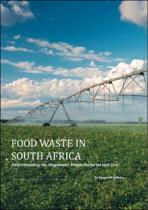 ResearchSpace
ResearchSpace
Food waste in South Africa: Understanding the magnitude, water footprint and cost
JavaScript is disabled for your browser. Some features of this site may not work without it.
- ResearchSpace
- →
- Research Publications/Outputs
- →
- Book Chapters
- →
- View Item
| dc.contributor.author |
Oelofse, Suzanna HH

|
|
| dc.date.accessioned | 2016-01-26T06:57:31Z | |
| dc.date.available | 2016-01-26T06:57:31Z | |
| dc.date.issued | 2014-11 | |
| dc.identifier.citation | Oelofse S.H.H. 2014. Food waste in South Africa: Understanding the magnitude, water footprint and cost. In: The vision zero waste handbook South Africa. Volume 4: The essential guide to resource efficiency in South Africa. Alive2green: Cape Town, South Africa | en_US |
| dc.identifier.isbn | 978-0-620-45067-6 | |
| dc.identifier.uri | http://issuu.com/alive2green/docs/waste_v4_web | |
| dc.identifier.uri | http://hdl.handle.net/10204/8367 | |
| dc.description | Copyright:Alive2green: Cape Town, South Africa | en_US |
| dc.description.abstract | Food is treated as a disposable commodity throughout the developed world (Oelofse and Nahman, 2013). It is estimated that between 30% and 50% (or 1.2-2 billion tonnes) of all food produced for human consumption is lost or wasted before consumption (Institution of Mechanical Engineers, 2013). It is further reported that food wastage in developing countries (including sub-Saharan Africa) tend to occur mostly in the production and distribution stages as compared to developed countries where the bulk of the wastage occur at the retail and consumer end of the supply chain (Institution of Mechanical Engineers, 2013). Dutch households are reported to waste 13.6% of edible food (Ministry of Economic Affairs, 2014) while UK households waste nearly 20% of the food they buy (Bond et al., 2013). Globally agriculture accounts for the largest human use of water (Lundqvist et al., 2008). This is of significance when considering that about 90 percent of local South African fruit, vegetables and wine are produced under irrigation (DAFF, 2012) and mostly for the export market (ITC, 2010). This chapter report on the food waste in South Africa: Understanding the magnitude, water footprint and cost. | en_US |
| dc.language.iso | en | en_US |
| dc.publisher | Alive2green | en_US |
| dc.relation.ispartofseries | Workflow;14982 | |
| dc.subject | Food waste | en_US |
| dc.subject | Water footprint | en_US |
| dc.title | Food waste in South Africa: Understanding the magnitude, water footprint and cost | en_US |
| dc.type | Book Chapter | en_US |
| dc.identifier.apacitation | Oelofse, S. H. (2014). Food waste in South Africa: Understanding the magnitude, water footprint and cost., <i>Workflow;14982</i> Alive2green. http://hdl.handle.net/10204/8367 | en_ZA |
| dc.identifier.chicagocitation | Oelofse, Suzanna HH. "Food waste in South Africa: Understanding the magnitude, water footprint and cost" In <i>WORKFLOW;14982</i>, n.p.: Alive2green. 2014. http://hdl.handle.net/10204/8367. | en_ZA |
| dc.identifier.vancouvercitation | Oelofse SH. Food waste in South Africa: Understanding the magnitude, water footprint and cost.. Workflow;14982. [place unknown]: Alive2green; 2014. [cited yyyy month dd]. http://hdl.handle.net/10204/8367. | en_ZA |
| dc.identifier.ris | TY - Book Chapter AU - Oelofse, Suzanna HH AB - Food is treated as a disposable commodity throughout the developed world (Oelofse and Nahman, 2013). It is estimated that between 30% and 50% (or 1.2-2 billion tonnes) of all food produced for human consumption is lost or wasted before consumption (Institution of Mechanical Engineers, 2013). It is further reported that food wastage in developing countries (including sub-Saharan Africa) tend to occur mostly in the production and distribution stages as compared to developed countries where the bulk of the wastage occur at the retail and consumer end of the supply chain (Institution of Mechanical Engineers, 2013). Dutch households are reported to waste 13.6% of edible food (Ministry of Economic Affairs, 2014) while UK households waste nearly 20% of the food they buy (Bond et al., 2013). Globally agriculture accounts for the largest human use of water (Lundqvist et al., 2008). This is of significance when considering that about 90 percent of local South African fruit, vegetables and wine are produced under irrigation (DAFF, 2012) and mostly for the export market (ITC, 2010). This chapter report on the food waste in South Africa: Understanding the magnitude, water footprint and cost. DA - 2014-11 DB - ResearchSpace DP - CSIR KW - Food waste KW - Water footprint LK - https://researchspace.csir.co.za PY - 2014 SM - 978-0-620-45067-6 T1 - Food waste in South Africa: Understanding the magnitude, water footprint and cost TI - Food waste in South Africa: Understanding the magnitude, water footprint and cost UR - http://hdl.handle.net/10204/8367 ER - | en_ZA |





